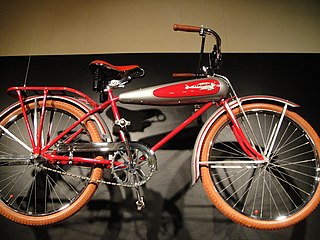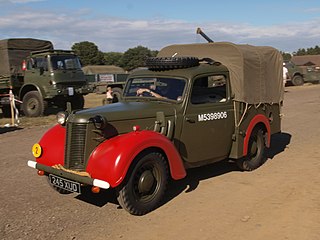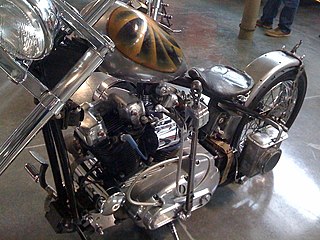
A chopper is a type of custom motorcycle which emerged in the US state of California in the late 1950s. A chopper employs modified steering angles and lengthened forks for a stretched-out appearance. They can be built from an original motorcycle which is modified ("chopped") or built from scratch. Some of the characteristic features of choppers are long front ends with extended forks often coupled with an increased rake angle, hardtail frames, very tall "ape hanger" or very short "drag" handlebars, lengthened or stretched frames, and larger than stock front wheel. To be considered a chopper a motorcycle frame must be cut and welded at some point. I.e. the name chopper. The "sissy bar", a set of tubes that connect the rear fender with the frame, and which are often extended several feet high, is a signature feature on many choppers.

The Honda Shadow refers to a family of cruiser-type motorcycles made by Honda since 1983. The Shadow line features motorcycles with a liquid-cooled 45 or 52-degree V-twin engine ranging from 125 to 1,100 cc engine displacement. The 250 cc Honda Rebel is associated with the Shadow line in certain markets.

The Raleigh Chopper is a children's / young adults bicycle, a wheelie bike, manufactured and marketed by the Raleigh Bicycle Company of Nottingham, England. The unique design became a cultural icon and is fondly remembered by many who grew up in that period. The design was influenced by dragsters, "chopped" motorcycles, beach buggies, and even chariots, as can be seen on the centre page of the 1969 Raleigh US catalogue. The bicycle has featured in many movies and TV series. MK1 models produced were from 1968 to 1972, MK2 models produced from 1972 to 1983 and MK3 models produced from 2004 to 2012 and sold through to 2018.

A softail motorcycle intentionally looks like vintage motorcycles with a rigid hard-tail frame that has a triangle of steel tubes at the rear axle, as on a bicycle frame, but on a Softail these tubes are actually a triangular swingarm, with the shock absorber(s) hidden, as opposed to clearly visible regular twin shocks on both sides of the rear wheel on standard bikes. Since the introduction of the Harley-Davidson FXST Softail in 1983 as a registered trademark of the Motor Company, softail has become a genericized trademark for other models of cruiser motorcycles with rear suspensions hidden for retro style reasons. This was done even though the rear wheel was often hidden behind bags or exhaust pipes.

The Huffy Corporation is a supplier of bicycles with headquarters in Dayton, Ohio, United States.

The six main types of motorcycles are generally recognized as standard, cruiser, touring, sports, off-road, and dual-purpose. Sport touring is sometimes recognized as a seventh category or integrated with the touring category.

A cruiser bicycle, also known as a beach cruiser or (formerly) motobike, is a bicycle that usually combines balloon tires, an upright seating posture, a single-speed drivetrain, and straightforward steel construction with expressive styling. Cruisers are popular among casual bicyclists and vacationers because they are very stable and easy to ride, but their heavy weight and balloon tires tend to make them rather slow. Another common feature is their ability to be customized with accessories including fenders, lights and saddle bags. They are designed for use primarily on paved roads, low speeds/distances, and are included in the non-racing/non-touring class and heavyweight or middleweight styles of the road bicycle type.

A bicycle trailer is a motorless wheeled frame with a hitch system for transporting cargo by bicycle. It can greatly increase a bike's cargo capacity, allowing point-to-point haulage of objects up to 3 cubic metres in volume that weigh as much as 500 kg. However, very heavily loaded trailers may pose a danger to the cyclist and others, and the voluntary European standard EN 15918 therefore suggests a maximum load of 60 kg on trailers without brakes.

The Harley-Davidson Sportster is a line of motorcycles produced continuously since 1957 by Harley-Davidson. Sportster models are designated in Harley-Davidson's product code by beginning with "XL". In 1952, the predecessors to the Sportster, the Model K Sport and Sport Solo motorcycles, were introduced. These models K, KK, KH, and KHK of 1952 to 1956 had a sidevalve engine, whereas the later XL Sportster models use an overhead valve engine. The first Sportster in 1957 had many of the same features of the KH including the frame, fenders, large gas tank and front suspension.

Fender is the American English term for the part of an automobile, motorcycle or other vehicle body that frames a wheel well. Its primary purpose is to prevent sand, mud, rocks, liquids, and other road spray from being thrown into the air by the rotating tire. Fenders are typically rigid and can be damaged by contact with the road surface.

The terms suicide clutch, and suicide shifter or jockey shifter, refer to some motorcycles' foot-operated clutch and hand shifter to change gears. Foot clutches (rocker-clutches) and hand shifters (tank-shifts) were found on early motorcycle designs from around the turn of the 20th century to the 1940s or 50s, and reappearing on modern retro styled custom motorcycles and choppers. Modern motorcycles do not require removing a hand from the handlebars to shift gears, using only the fingers for the clutch and the toes of one foot to select gears. In contrast, the fanciful slang "suicide" was applied to designs where the rider removes one hand to change gears, or cannot put both feet on the ground while using a foot clutch to disengage the transmission. Sometimes the shifter is referred to as a "jockey shifter" while the foot clutch is called a "suicide clutch".
The Harley-Davidson Super Glide was a motorcycle made by the Harley-Davidson. Reputed to be the first factory custom motorcycle, it originated Harley-Davidson's FX series of motorcycles by mating Sportster components, most notably the front end, with the chassis of their larger big twin motorcycles. Super Glide models from 1991 to 2018 were based on the Dyna Glide chassis which has a wider variety of front ends and trim levels, and for a time filled the intermediate niche between the smallest and largest Harley-Davidson models; the Dyna platform has since been discontinued for the 2018 model year in favor of the new Softail frame, with some models from the Dyna nameplate being carried over to the Softail line.

A bicycle handlebar is the steering control for bicycles. It is the equivalent of a tiller for vehicles and vessels, as it is most often directly mechanically linked to a pivoting front wheel via a stem which in turn attaches it to the fork. Besides steering, handlebars also often support a portion of the rider's weight, depending on their riding position, and provide a convenient mounting place for brake levers, shift levers, cyclocomputers, bells, etc.
Motorcycle components and systems for a motorcycle are engineered, manufactured, and assembled in order to produce motorcycle models with the desired performance, aesthetics, and cost. The key components of modern motorcycles are presented below.
Orange County Choppers bikes are motorcycles featured on the television series American Chopper built by Orange County Choppers (OCC) for a specific corporate or celebrity customer. Theme bikes are motorcycles in which the theme of the motorcycle takes priority over everything else, influencing the frame dimensions, paint scheme, and overall 'feel' of the motorcycle. The function of motorcycle usually takes a backseat to the presentation of the theme, and these motorcycles attract attention solely on the premise of the theme itself. Customer bikes are built for and generally to the specifications of a particular customer. Although the customers typically give OCC creative freedom to do what they will, some clients have a specific idea in mind and expect OCC to reproduce their mental picture literally.

A bobber, originally called a bob-job from the 1930s through 1990s, is a style of custom motorcycle. The typical construction includes removing the front fender, shortening the rear fender, which is "bobbed", and stripping excess bodywork as well as all superfluous parts to reduce weight.
Motorcycle accessories are features and accessories selected by a motorcycle owner to enhance safety, performance, or comfort, and may include anything from mobile electronics to sidecars and trailers. An accessory may be added at the factory by the original equipment manufacturer or purchased and installed by the owner post-sale as aftermarket goods. The term Farkle is used within the motorcycle community, originally to denote useful add-ons, such as GPS or other upgraded components. Now also used at times in a humorous or mildly derogatory way to describe bling, such as anodized or chromed parts that add no functionality.

A wheelie bike, also called a dragster, muscle bike, high-riser, spyder bike or banana bike, is a type of stylized children's bicycle designed in the 1960s to resemble a chopper motorcycle and characterized by ape hanger handlebars, a banana seat with sissy bar, and small wheels. Notable examples include the Schwinn Sting-Ray and Krate lines and the Raleigh Chopper line. Other notable manufacturers and retailers that offered models include AMF, CCM, Columbia, Huffy, Iverson, J. C. Penney, Malvern Star, Monark, Murray, Ross, Sears, and Vindec.

The following outline is provided as an overview of motorcycles and motorcycling:
















